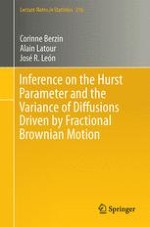The first theorem of this chapter establishes the almost sure convergence for the
k-power second order increments of the fractional Brownian motion (fBm) toward the
k-th moment of a standard normal distribution. Then we give the rate of this convergence in law. Moreover, for a general functional variation of the fBm, see (
2.4), page 40, including the absolute
k-power variation, the result remains true. This allows us to propose several estimators of the Hurst parameter
H for the fBm using classical linear regression. The first one,
\(\hat{H}_{k}\), uses the function
\(\left \vert x\right \vert ^{k}\), and the second one,
\(\hat{H}_{\log }\), uses the Napierian logarithm and both lead to unbiased consistent estimators. A Central Limit Theorem (CLT) is also obtained for both estimators. These estimators are linked in the sense that if
k(
n) is a sequence of positive numbers converging to zero with
\(n\), and if
\(\hat{H}_{k(n)}\) denotes the corresponding estimator of the
H parameter, we set out that the asymptotic behaviors of
\(\hat{H}_{k(n)}\) and of
\(\hat{H}_{\log }\) are the same. The same techniques can be used to provide simultaneous estimators of parameter
H and of the local variance
σ, in four particular simple models all driven by a fBm. As before, a regression model can be written and least squares estimators of
H and of
σ are defined. These estimators are built on the second order increments of the stochastic process solution of the proposed model. We prove their consistency and a CLT is given for both of them. Furthermore, we consider testing the hypothesis
σ
n
=
σ against an alternative in the four previous models. Finally, we propose functional estimation of the local variance of general stochastic differential equation (SDE). This estimation is based on the observation of the second order increments of the solution of such an SDE. We highlight that to show the convergence in these models, it is sufficient to prove it in the special case where the solution process is the fBm.
